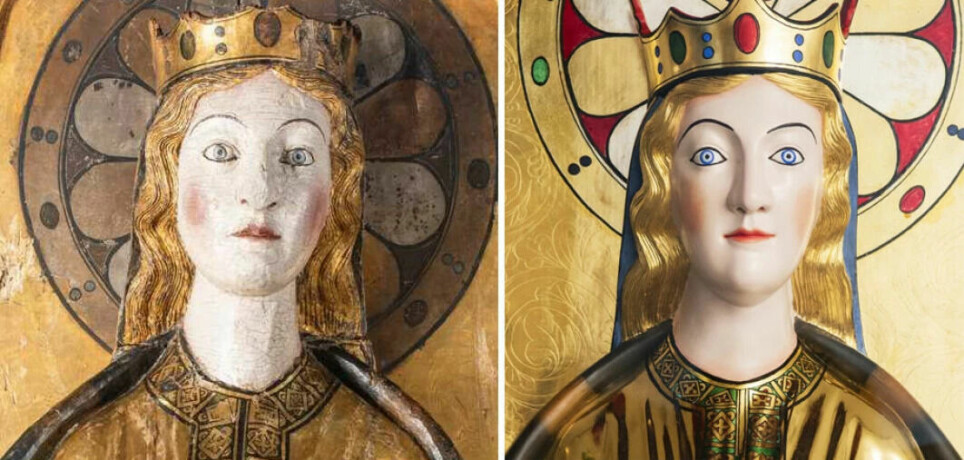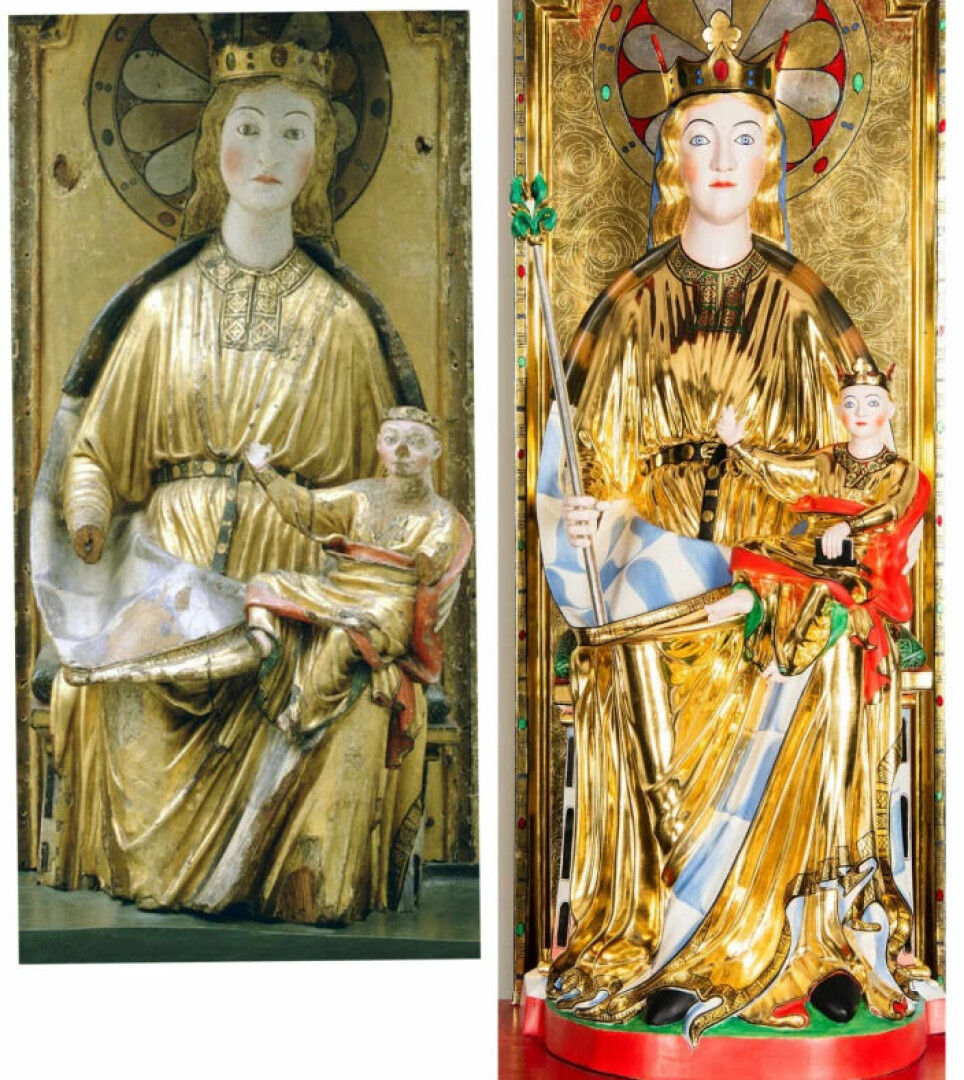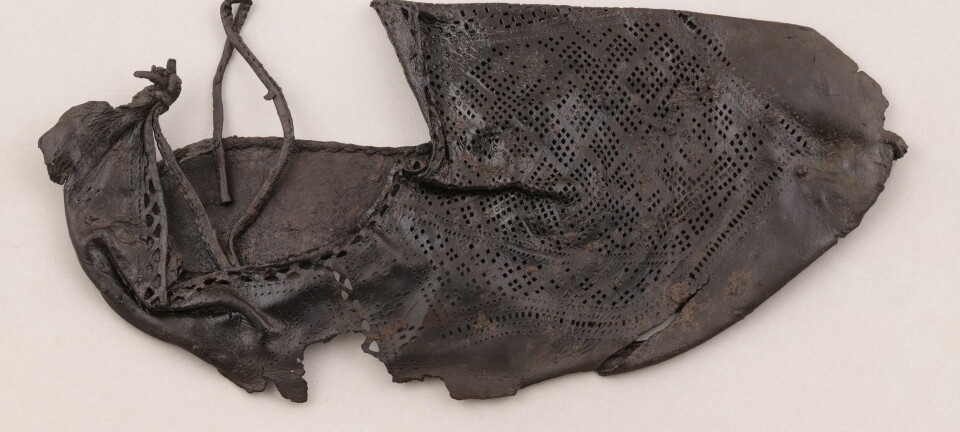
This is what an ancient Mary and Jesus statue would have looked like 800 years ago
An ancient statue in Norway has been recreated. It shows us how Jesus and Mary may have looked when the statue came to Norway 800 years ago.
The 800-year-old statue is on display at the University Museum of Bergen. The baby Jesus is missing his nose and left hand; Maria has lost her right hand, and someone has cut off her feet. The colours are faded.
The statue is called Hovemadonnaen, and now two exist.
The new statue is painted in bright colours with lots of gold. Jesus and Mary now have a full set of hands and feet, and they also look freshly made up.
Just before summer, the new statue arrived at Hove church in Vik, right where the old one stood for hundreds of years.

Mary was the people’s spokeswoman
The original statue arrived at the church in Western Norway during the 13th century, when Norway was considered to be a Catholic country.
During that time, statues of Mary and other holy figures were important to Christians. They turned to Mary to convey their messages to God.
“Mary was your spokeswoman,” Alf Tore Hommedal tells sciencenorway.no. He is an archaeologist at the University Museum of Bergen and researches old church buildings.
The statue was likely made by craftsmen in the south of Europe and then sent by ship to Norway. When it was first placed on the altar in Hove church, Hommedal believes it must have been quite a sight.
“It was dark in the churches at that time. A little light would come in through the windows and doors, but otherwise all they had was candlelight. That probably made the statue look absolutely fantastic – completely heavenly,” he says.
Not as important anymore
After 300 years – in the 16th century – the Reformation came to Norway. According to Martin Luther's teachings, you should only pray directly to God. There was no longer a need for any intercession via Mary. Many pictures and statues from Catholic times were therefore removed. However, Mary and Jesus were allowed to stay in Hove church, just not in such an important place as the altar.
The statue was allowed to stand for several hundred more years before it was moved to the museum in Bergen in 1840.
This caused some problems in Vik, as many wanted the statue back. After all, it had been in their church for several hundred years. It belonged there and was theirs, they argued.

No, no and then yes
Since then, people in Vik have been working to get the statue of Mary and Jesus back. But the museum said no. The ancient and fragile statue had to be stored in appropriate conditions so as not to be destroyed even more.
Then the people in Vik asked to make a new version of Hovemadonnaen. The museum still said no. They were still worried about more damages to the original statue.
Five years ago, however, things picked up speed. A committee in Vik had collected enough money, and new technology had arrived. Now it was possible to 3D scan the statue without damaging it at all. And so the work on creating a new version of Hovemadonnaen began.
It wasn't easy.
The goal was for the new statue to be as similar to the original as possible, but they also had to add the missing parts. What did Maria's shoes look like on the original? And what were Mary and the baby Jesus holding in their hands? And finally, what colours should they use?
Very bright colours
Together with Justin Kroesen, a research curator of church art, a group of researchers at the University Museum of Bergen figured out what to do.
They studied similar figures from the same time that Hovemadonnaen was made and looked at other statues in Norwegian churches.
“We knew they used bright colours. Very bright colours, almost too much of a good thing. It was necessary in the dark churches,” says Hommedal.
Mary was given a scepter of lilies in her new hand.
“We are quite sure that the original Mary also held lilies. But we are not sure how her feet were shaped, and whether she wore black or red shoes,” Hommedal says.
“The new statue is not a faithful copy of the old one, as it looked when it was new in the 13th century. It is however as similar as it is possible to be with the knowledge we have today," he says.

Jesus is the most important
Jesus was given a book in his new hand.
“With his other hand he is holding two fingers up in the air, indicating that he is giving a speech. He is sitting there preaching God's word,” says Hommedal.
Because really, it is the baby Jesus who is most important.
“Mary sits on a throne, and many people think that she is the most central. But Jesus is the main character. Mary's lap is, in a way, his throne,” he says.
Both look heavily made up.
“It can almost look like clown make-up, but they had to exaggerate their features when the statue was made because of the extremely poor lighting,” says Hommedal.
White or dark skin?
Mary and Jesus have light hair, blue eyes and very white skin. This does not match with historical facts, as they came from the Middle East where people have dark hair and skin.
“Those who made the original statue in the Middle Ages were probably aware of this. But they brought Mary and Jesus into their own contemporary culture to make them relevant. It was common at the time, but Mary was also portrayed with black skin,” Hommedal says.
———
Translated by Alette Bjordal Gjellesvik.
Read the Norwegian version of this article on ung.forskning.no
Sources:
The University Museum of Bergen, årbok 2021, Nordisk Trykk (link in Norwegian).
Eivind Fondenes, Lager kopi av unik 800 år gammel kunstskatt (Is making a copy of a unique 800-year-old artistic treasure), Article on uib.no (link in Norwegian).
------

































